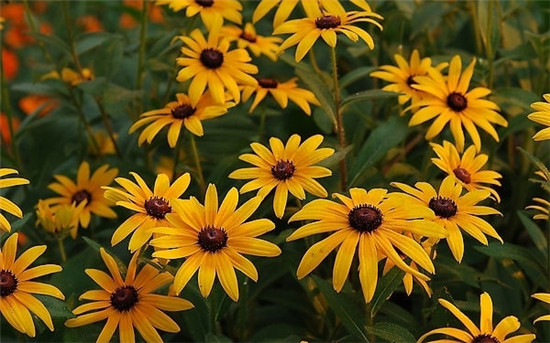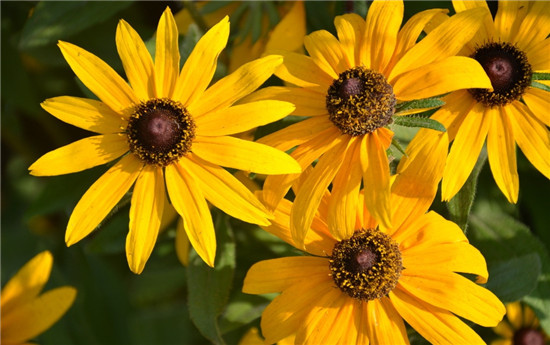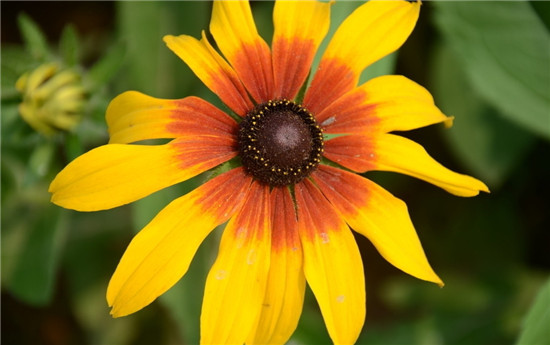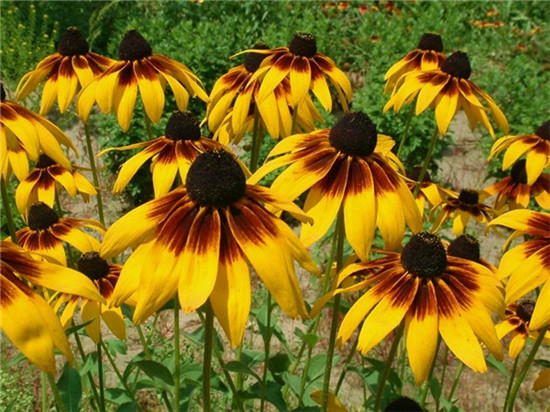Culture methods of Chrysanthemum morifolium Culture skills of Chrysanthemum morifolium
Black-hearted chrysanthemum, native to the eastern United States, is a 2012 herb. Let's take a look at the cultivation of black-hearted chrysanthemum.

Chrysanthemum, of the family Compositae, born in 2012, with a height of 60-100cm, a head of 8-9cm, double flowers, yellow ligulate flowers, sometimes brown yellow bands, and dark brown tubular flowers. Branches and leaves rough, much branched. Leaf blade broad, basal leaves pinnately divided, 5-7-lobed, cauline leaves 3-5-lobed, margin sparsely serrate. Inflorescences capitate to several springs on long peduncles. Spring and autumn sowing, flowering summer to autumn, cold and drought tolerance, extensive management, cluster planting, highway greening, flower bed flower border, grass edge planting. It can also be used as cut flowers, overwintering in the open field, and can be self-sown and reproduce. The whole plant is hairy, near the root leaves, the upper leaves alternate, the leaves are spatulate and broadly lanceolate, the leaf margin is coarsely dentate. Inflorescence head. Ligulate flowers in single whorl, golden yellow; tubular flowers deep black chrysanthemum brown, hemispherical.

Plant stem
Black heart chrysanthemum belongs to the genus Chrysanthemum of Compositae, which is born in 2012, with a height of 60-100cm, stout stems, soft hairs, slightly branched and winged.
Leaf
The proximal root of the black chrysanthemum leaves, the upper leaves alternate, the leaves are spoon-shaped and broadly lanceolate, and the leaf margin is coarsely dentate. Inflorescence head. Alternate leaves rough, long elliptic to narrowly lanceolate, 10-15cm long, leaf base extending to stem winglike, pinnatifid, 5-7-lobed, cauline leaves 3-5-lobed, margin sparsely serrate.
Flowers
Black heart chrysanthemum is a capitate inflorescence of 8-9cm, about 2.5-5cm in diameter, corymbose, with short pedicels; double flowers, ligulate flowers yellow, sometimes brown yellow bands, tubular flowers dark brown. Capitate, ligulate flowers neutral, 1.5-2cm long, yellow, brownish purple or with bichromatic stripes; tubular flowers brown to purple, densely globose; black-core chrysanthemum from June to October.

Propagation methods of Chrysanthemum morifolium
Sowing and reproduction
The sowing time of black chrysanthemum is usually in spring and autumn. March in spring and September in autumn are the best sowing time for natural growth. The sowing time is closely related to its natural flowering period: sowing in March in spring, flowering from June to July, sowing in autumn in September, planting in November, and flowering in spring the following year (May to June). In order to ensure that the plant is robust and the flowers are large and colorful, a transplant should be carried out when 4 to 5 leaves grow after sowing. It was planted in November. You can spend the winter in the open.
Ramet propagation
It can be carried out in both spring and autumn, and the old perennial plants are generally divided.
Cuttage propagation
Generally, the new buds sprouting from the roots are selected as cuttings, which can be carried out in spring or autumn. It should be carried out when sprouting and sprouting to about 15cm in spring and after rhizosphere sprouting after flowering in autumn.

Cultivation and management
Black-hearted chrysanthemum is fond of sun-ventilated growth environment, cold and drought tolerance, regardless of soil. The management is relatively extensive. More land planting, suitable for growing in sandy loam. The requirement of water and fertilizer is not strict. When the plant grows well, it can adapt to top dressing with nitrogen, phosphorus and potassium fertilizer to make the black-hearted chrysanthemum flowers more beautiful. There should be sufficient light during the growth period. Especially for cut flower plants, the flowering period can be prolonged by coring method. For perennial plants, it is necessary to force ramet, otherwise it will weaken the growth and affect flowering.
The Garden use of Chrysanthemum morifolium
Black-hearted chrysanthemum flowers are luxuriant, suitable for courtyard layout, flower border materials, or natural planting on the edge of grass.
The new strain of Chrysanthemum morifolium is an award-winning variety in Europe, which has won AASWinner and FleuroselectAwards. These strains provide a variety of varieties and provide customers with a variety of excellent choices for windowsill plants, park potted plants, regional planting or background plants, as main flowers or concentrated cultivation. They have the following outstanding advantages:
1. It has bright colors, which greatly improves the appearance attractiveness.
two。 It continues to bloom for a very long time, increasing sales opportunities.
3. Gardens are award-winning varieties in Europe, and their excellent characteristics have been recognized.
4. There is a wide choice of growth habits and floral forms, so it is possible to be widely used.
5. Heat-resistant and durable, which increases consumer satisfaction.
The above is the whole content of the breeding methods and techniques of black-hearted chrysanthemum, which I have summarized for you. I hope this article can help you. Please continue to follow us.
Related
- Wuhan Hospital Iron Tree Blooming Result Was Instantly Frightened by the Gardener Master
- Which variety of camellia is the most fragrant and best? Which one do you like best?
- What is the small blue coat, the breeding methods and matters needing attention of the succulent plant
- Dormancy time and maintenance management of succulent plants during dormancy
- Minas succulent how to raise, Minas succulent plant pictures
- What are the varieties of winter succulent plants
- How to raise succulent plants in twelve rolls? let's take a look at some experience of breeding twelve rolls.
- Attention should be paid to water control for succulent plants during dormant period (winter and summer)
- Watering experience of twelve rolls of succulent plants
- Techniques for fertilizing succulent plants. An article will let you know how to fertilize succulent plants.



